Gamma Attenuation Features of White Cement Mortars Reinforced by Micro/Nano Bi2O3 Particles
Abstract
:1. Introduction
2. Materials and Methods
2.1. Materials
2.2. Preparation of Specimens
2.3. Morphology Test
2.4. Radiation Shielding Properties
3. Results and Discussion
4. Conclusions
Author Contributions
Funding
Institutional Review Board Statement
Informed Consent Statement
Data Availability Statement
Conflicts of Interest
References
- Kamislioglu, M. Research on the effects of bismuth borate glass system on nuclear radiation shielding parameters. Results Phys. 2021, 22, 103844. [Google Scholar] [CrossRef]
- Sazali, M.A.; Rashid, N.K.A.; Hamzah, K. A review on multilayer radiation shielding. IOP Conf. Ser. Mater. Sci. Eng. 2019, 555. [Google Scholar] [CrossRef]
- Sikora, P.; El-Khayatt, A.M.; Saudi, H.; Chung, S.-Y.; Stephan, D.; Elrahman, M.A. Evaluation of the effects of bismuth oxide (Bi2O3) micro and nanoparticles on the mechanical, microstructural and γ-ray/neutron shielding properties of Portland cement pastes. Constr. Build. Mater. 2021, 284, 122758. [Google Scholar] [CrossRef]
- Eid, M.S.; Bondouk, I.; Saleh, H.M.; Omar, K.M.; Sayyed, M.; El-Khatib, A.M.; Elsafi, M. Implementation of waste silicate glass into composition of ordinary cement for radiation shielding applications. Nucl. Eng. Technol. 2021, 54, 1456–1463. [Google Scholar] [CrossRef]
- AbuAlRoos, N.J.; Amin, N.A.B.; Zainon, R. Conventional and new lead-free radiation shielding materials for radiation protec-tion in nuclear medicine: A review. Radiat. Phys. Chem. 2019, 165, 108439. [Google Scholar] [CrossRef]
- Sayyed, M.I.; Akman, F.; Kaçal, M.R.; Kumar, A. Radiation protective qualities of some selected lead and bismuth salts in the wide gamma energy region. Nucl. Eng. Technol. 2019, 51, 860–866. [Google Scholar] [CrossRef]
- Almisned, G.; Zakaly, H.M.H.; Issa, S.A.M.; Ene, A.; Kilic, G.; Bawazeer, O.; Almatar, A.; Shamsi, D.; Rabaa, E.; Sideig, Z.; et al. Gamma-Ray Protection Properties of Bismuth-Silicate Glasses against Some Diagnostic Nuclear Medicine Radioisotopes: A Comprehensive Study. Materials 2021, 14, 6668. [Google Scholar] [CrossRef]
- Zaid, M.; Matori, K.; Sidek, H.; Ibrahim, I. Bismuth modified gamma radiation shielding properties of titanium vanadium sodium tellurite glasses as a potent transparent radiation-resistant glass applications. Nucl. Eng. Technol. 2020, 53, 1323–1330. [Google Scholar] [CrossRef]
- El-Khatib, A.M.; Abbas, A.M.; Hammoury, S.I.; Gouda, M.M.; Zard, K.; Elsafi, M. Effect of PbO-Nanoparticles on Dime-thyl Polysiloxane for use in Radiation Shielding Applications. Sci. Rep. 2022, 12, 15722. [Google Scholar] [CrossRef]
- Abbas, M.I.; El-Khatib, A.M.; Dib, M.F.; Mustafa, H.E.; Sayyed, M.I.; Elsafi, M. The Influence of Bi2O3 Nanoparticle Content on the γ-ray Interaction Parameters of Silicon Rubber. Polymers 2022, 14, 1048. [Google Scholar] [CrossRef]
- Elsafi, M.; Dib, M.F.; Mustafa, H.E.; Sayyed, M.I.; Khandaker, M.U.; Alsubaie, A.; Almalki, A.S.A.; Abbas, M.I.; El-Khatib, A.M. Enhancement of Ceramics Based Red-Clay by Bulk and Nano Metal Oxides for Photon Shielding Features. Materials 2021, 14, 7878. [Google Scholar] [CrossRef]
- Temir, A.; Zhumadilov, K.; Zdorovets, M.; Kozlovskiy, A.; Trukhanov, A. Study of gamma radiation shielding efficiency with radiation-resistant Bi2O3-TeO2-WO3 ceramics. Solid State Sci. 2021, 115, 106604. [Google Scholar] [CrossRef]
- Bani-Ahmad, M.M.; Azman, N.Z.N.; Jasmine, J.N.Z.; Almarri, H.M.; Alshipli, M.; Ramazun, M.R. Radiation attenuation abil-ity of bentonite clay enriched with eggshell as recyclable waste for a physical rradiation barrier. Radiat. Phys. Chem. 2022, 201, 110484. [Google Scholar] [CrossRef]
- Plangpleng, N.; Charoenphun, P.; Polpanich, D.; Sakulkaew, K.; Buasuwan, N.; Onjun, O.; Chuamsaamarkkee, K. Flexible gamma ray shielding based on natural Rubber/ BaSO4 nanocomposites. Radiat. Phys. Chem. 2022, 199, 110311. [Google Scholar] [CrossRef]
- El-Khatib, A.M.; Abbas, M.I.; Elzaher, M.A.; Badawi, M.S.; Alabsy, M.T.; Alharshan, G.A.; Aloraini, D.A. Gamma Attenuation Coefficients of Nano Cadmium Oxide/High density Polyethylene Composites. Sci. Rep. 2019, 9, 16012. [Google Scholar] [CrossRef]
- Tekin, H.; Sayyed, M.; Issa, S.A. Gamma radiation shielding properties of the hematite-serpentine concrete blended with WO3 and Bi2O3 micro and nano particles using MCNPX code. Radiat. Phys. Chem. 2018, 150, 95–100. [Google Scholar] [CrossRef]
- Khalaf, M.A.; Cheah, C.B.; Ramli, M.; Ahmed, N.M.; Al-Shwaiter, A. Effect of nano zinc oxide and silica on mechanical, fluid transport and radiation attenuation properties of steel furnace slag heavyweight concrete. Constr. Build. Mater. 2020, 274, 121785. [Google Scholar] [CrossRef]
- El-Khatib, A.M.; Shalaby, T.I.; Antar, A.; Elsafi, M. Experimental Study of Polypropylene with Additives of Bi2O3 Nanoparti-cles as Radiation-Shielding Materials. Polymers 2022, 14, 2253. [Google Scholar] [CrossRef]
- Nikbin, I.M.; Shad, M.; Jafarzadeh, G.A.; Dezhampanah, S. An experimental investigation on combined effects of nano-WO3 and nano-Bi2O3 on the radiation shielding properties of magnetite concretes. Prog. Nucl. Energy 2019, 117. [Google Scholar] [CrossRef]
- Zhang, Q.-P.; Xu, Y.-C.; Li, J.-L.; Liu, A.-J.; Xu, D.-G.; Wei, M.; Zhou, Y.-L. Hunting for advanced low-energy gamma-rays shielding materials based on PbWO4 through crystal defect engineering. J. Alloys Compd. 2020, 822, 153737. [Google Scholar] [CrossRef]
- El-Khatib, A.M.; Elsafi, M.; Almutiri, M.N.; Mahmoud, R.M.M.; Alzahrani, J.S.; Sayyed, M.I.; Abbas, M.I. Enhancement of Bentonite Materials with Cement for Gamma-Ray Shielding Capability. Materials 2021, 14, 4697. [Google Scholar] [CrossRef]
- Livitsanos, G.; Shetty, N.; Verstrynge, E.; Wevers, M.; Van Hemelrijck, D.; Aggelis, D.G. COST Action TU1404, Early Age Cracking and Serviceability in Cement-based Materials and Structures Shear failure characterization in masonry components made with different mortars based on combined NDT methods. Constr. Build. Mater 2019, 220, 690–700. [Google Scholar] [CrossRef]
- Zengin, B.; Oktay, D.; Ulukaya, S.; Yüzer, N. The effect of mortar type and joint thickness on mechanical properties of con-ventional masonry walls. Struct. Eng. Mech. 2018, 67, 579–585. [Google Scholar]
- Gouda, M.M. Calibration of NaI (Tl) cylindrical detector using axially shifted radioactive cylindrical sources. Nucl. Technol. Radiat. Prot. 2019, 34, 353–360. [Google Scholar] [CrossRef]
- Sayyed, M.I.; Elsafi, M.; Almuqrin, A.H.; Cornish, K.; El-Khatib, A.M. Novel Shielding Mortars for Radiation Source Trans-portation and Storage. Sustainability 2022, 14, 1248. [Google Scholar] [CrossRef]
- Hayouni, Y.; Gallala, W.; Gaied, M.E.; Plank, J.; Bourham, M.; Alsmadi, Z.Y. Enhanced Shielding and Mechanical Properties of White Cement Mortars Via Celestobarite Fine Aggregate. Int. J. Eng. Technol. 2021, 10, 1–16. [Google Scholar]
- Badawi, M.S.; Ruskov, I.; Gouda, M.M.; El-Khatib, A.M.; Alotiby, M.F.; Mohamed, M.M.; Thabet, A.A.; Abbas, M.I. A numerical approach to calculate the full-energy peak efficiency of HPGe well-type detectors using the effective solid angle ratio. J. Instrum. 2014, 9, 07030. [Google Scholar] [CrossRef]
- El-Khatib, A.M.; Abbas, M.I.; Sayyed, M.I.; Khandaker, M.U.; Abd-Elzaher, M.; Khalil, M.M.; Elsafi, M.; Gouda, M.M. Assess-ment of γ-radiation shielding behavior of some mixed nature clays. Radiat. Phys. Chem. 2022, 200, 110236. [Google Scholar] [CrossRef]
- Mahmoud, M.E.; El-Khatib, A.M.; Badawi, M.S.; Rashad, A.R.; El-Sharkawy, R.M.; Thabet, A.A. Fabrication, characterization and gamma rays shielding properties of nano and micro lead oxide-dispersed-high density polyethylene composites. Radiat. Phys. Chem. 2018, 145, 160–173. [Google Scholar] [CrossRef]
- Baltas, H.; Sirin, M.; Celik, A.; Ustabas, I.; El-Khayatt, A.M. Radiation shielding properties of mortars with minerals and ores additives. Cem. Concr. Compos. 2019, 97, 268–278. [Google Scholar] [CrossRef]
- Alalawi, A.; Eke, C.; Alzahrani, N.J.; Alomairy, S.; Alsalmi, O.; Sriwunkum, C.; Alrowaili, Z.A.; Al-Buriahi, M.S. Attenuation properties and radiation protection efficiency of Tb2O3-La2O3-P2O5 glass system. J. Aust. Ceram. Soc. 2022, 58, 511–519. [Google Scholar] [CrossRef]
- Mahmoud, K.A.; Sayyed, M.I.; Tashlykov, O.L. Gamma ray shielding characteristics and exposure buildup factor for some natural rocks using MCNP-5 code. Nucl. Eng. Technol. 2019, 51, 1835–1841. [Google Scholar] [CrossRef]
- Sharaf, J.M.; Saleh, H. Gamma-ray energy buildup factor calculations and shielding effects of some Jordanian building structures. Radiat. Phys. Chem. 2015, 110, 87–95. [Google Scholar] [CrossRef]
- Alabsy, M.T.; Alzahrani, J.S.; Sayyed, M.I.; Abbas, M.I.; Tishkevich, D.I.; El-Khatib, A.M.; Elsafi, M. Gamma-Ray Attenuation and Exposure Buildup Factor of Novel Polymers in Shielding Using Geant4 Simulation. Materials 2021, 14, 5051. [Google Scholar] [CrossRef]
- Gerward, L.; Guilbert, N.; Jensen, K.B.; Levring, H. WinXCom—A program for calculating X-ray attenuation coefficients. Radiat. Phys. Chem. 2004, 71, 653–654. [Google Scholar] [CrossRef]
- Gouda, M.M.; Abbas, M.I.; Hammoury, S.I.; Zard, K.; El-Khatib, A.M. Nano tin oxide/dimethyl polysiloxane reinforced composite as a flexible radiation protecting material. Sci. Rep. 2023, 13, 210. [Google Scholar] [CrossRef] [PubMed]

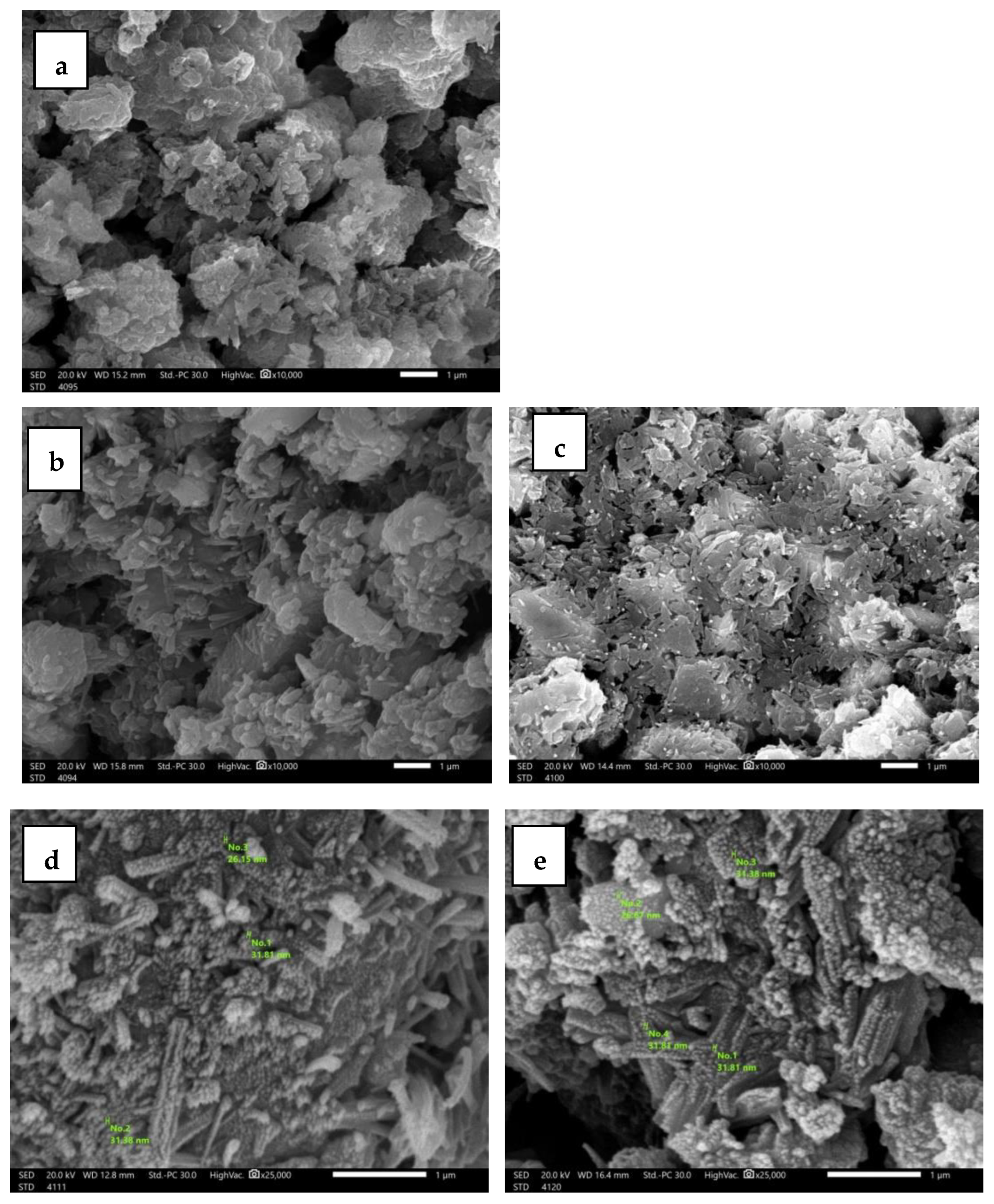
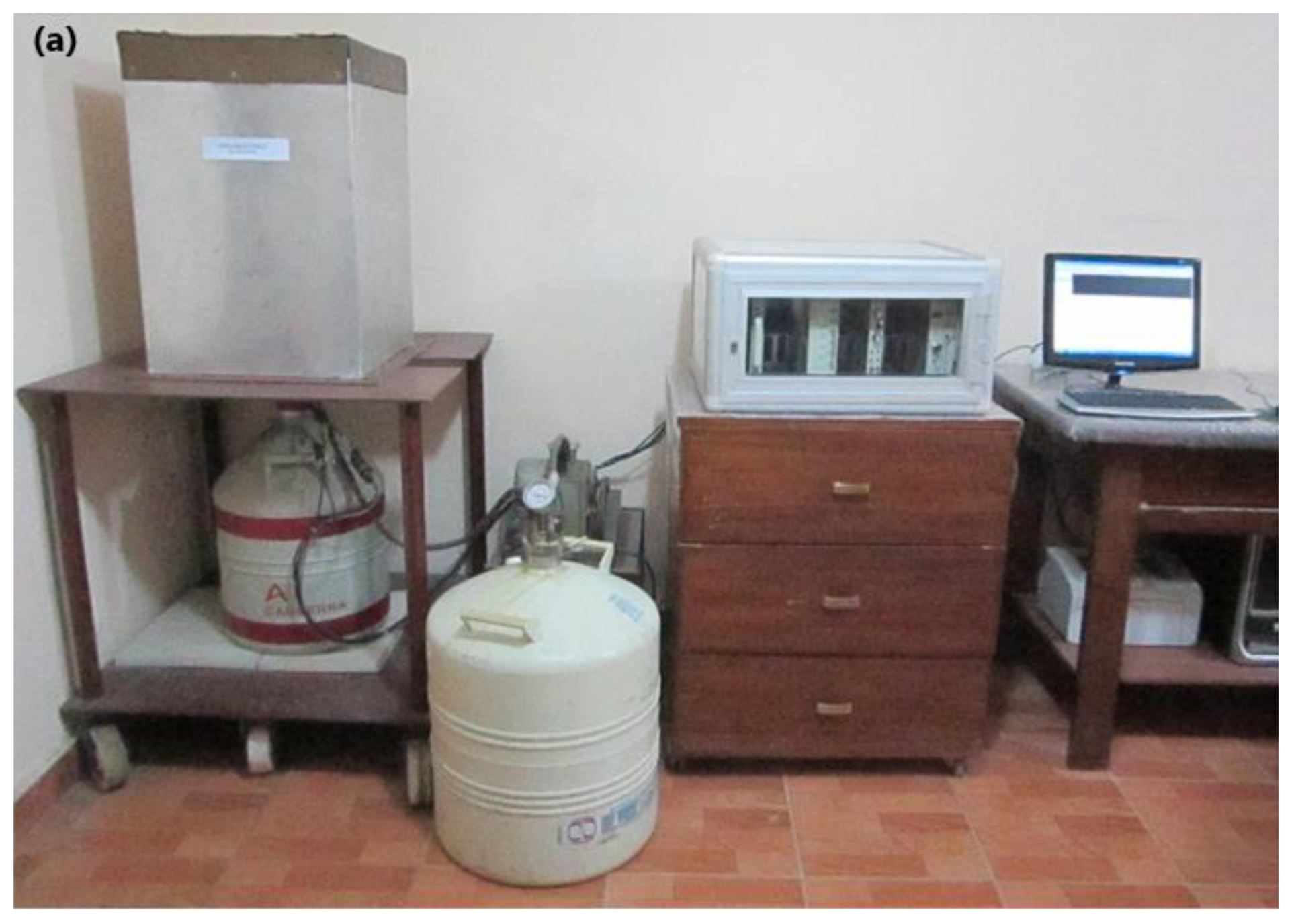
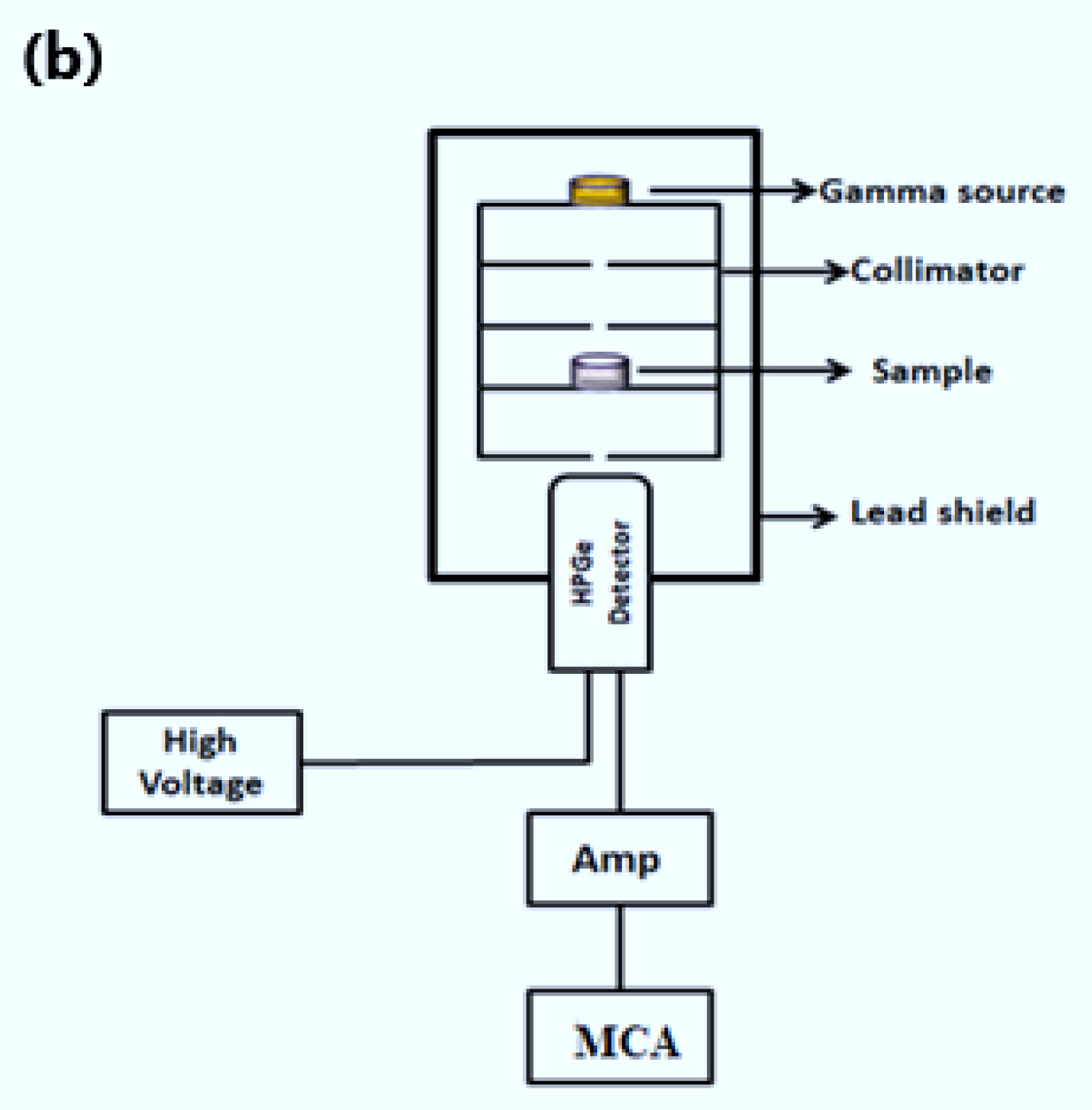

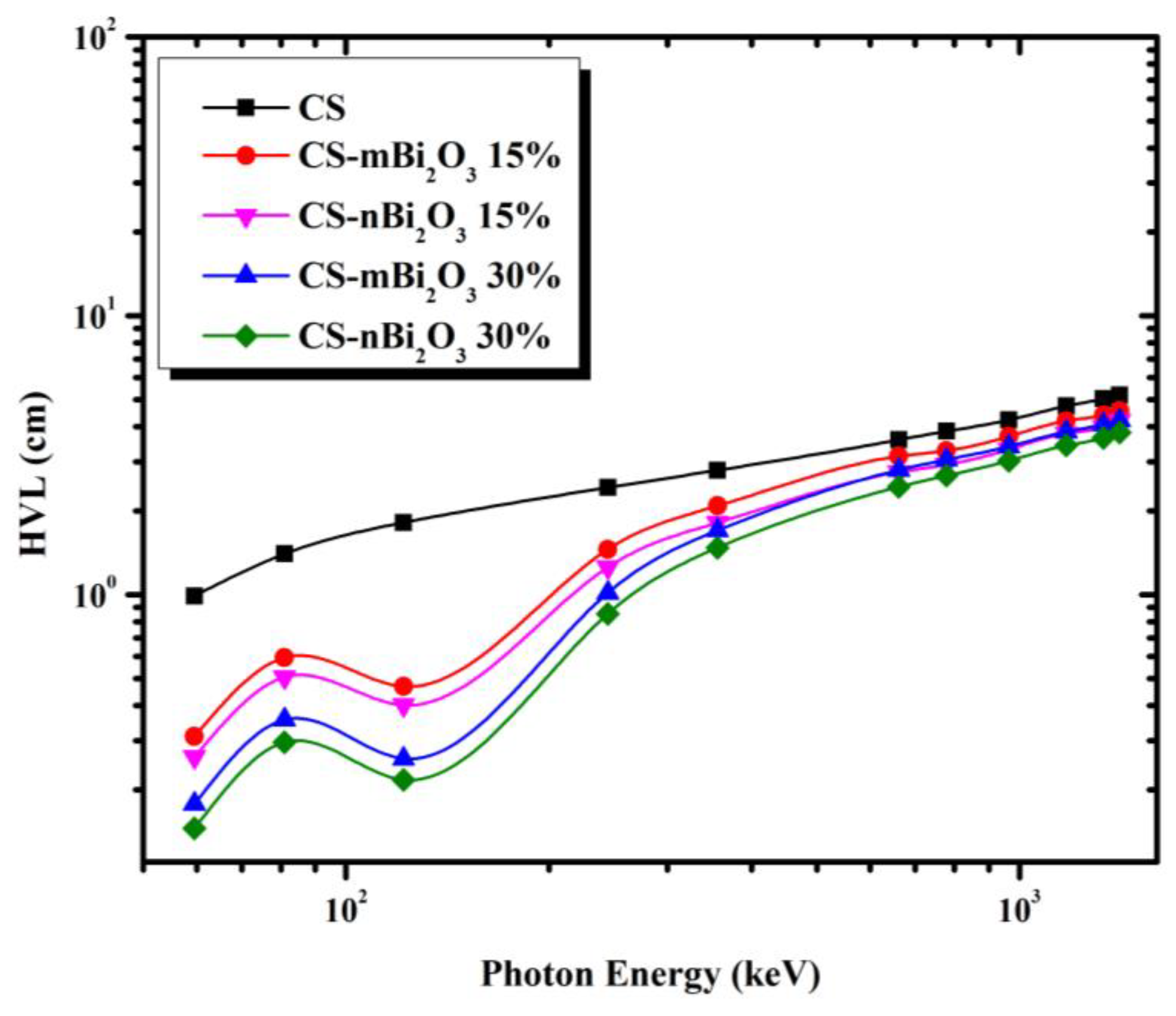

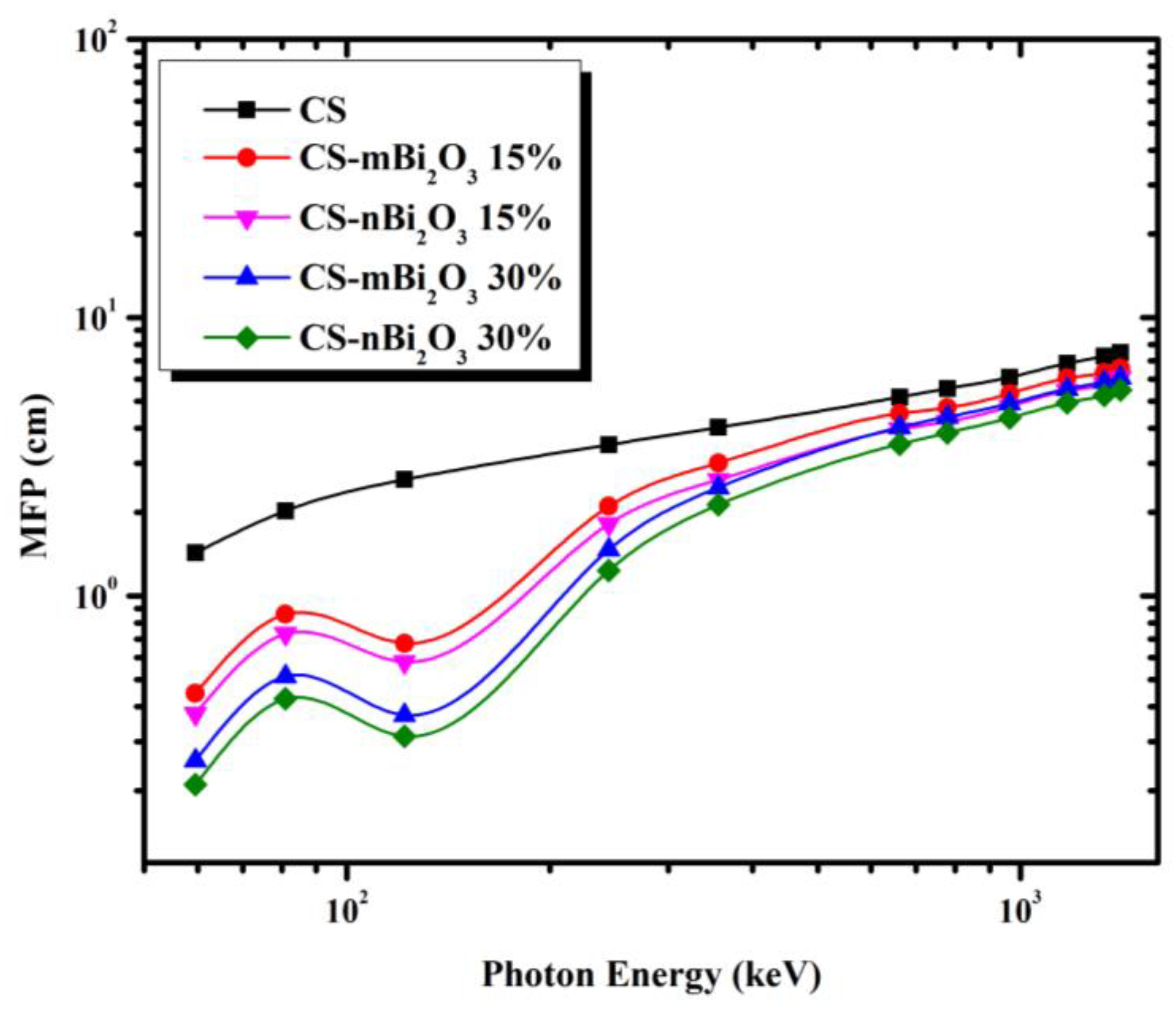
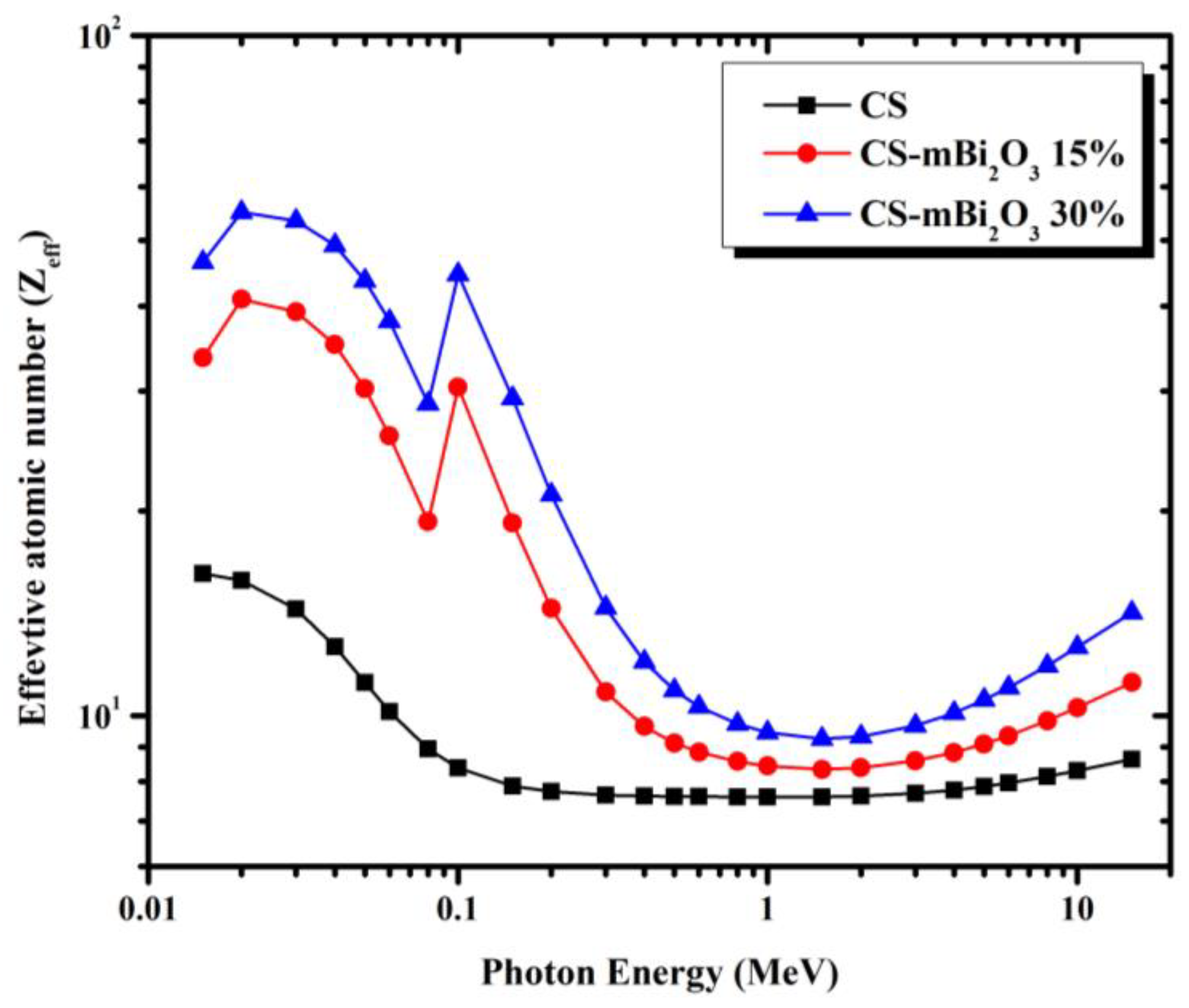
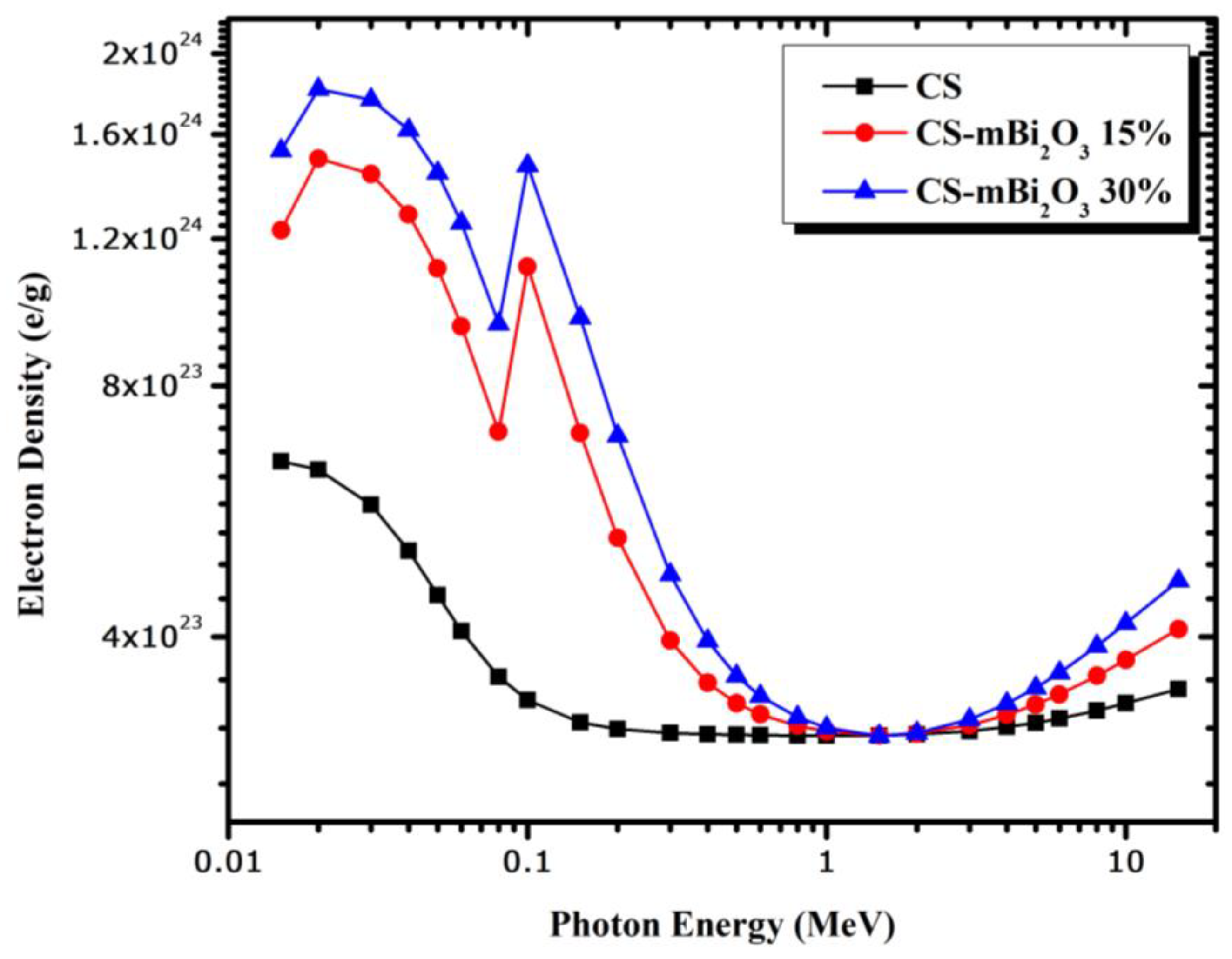
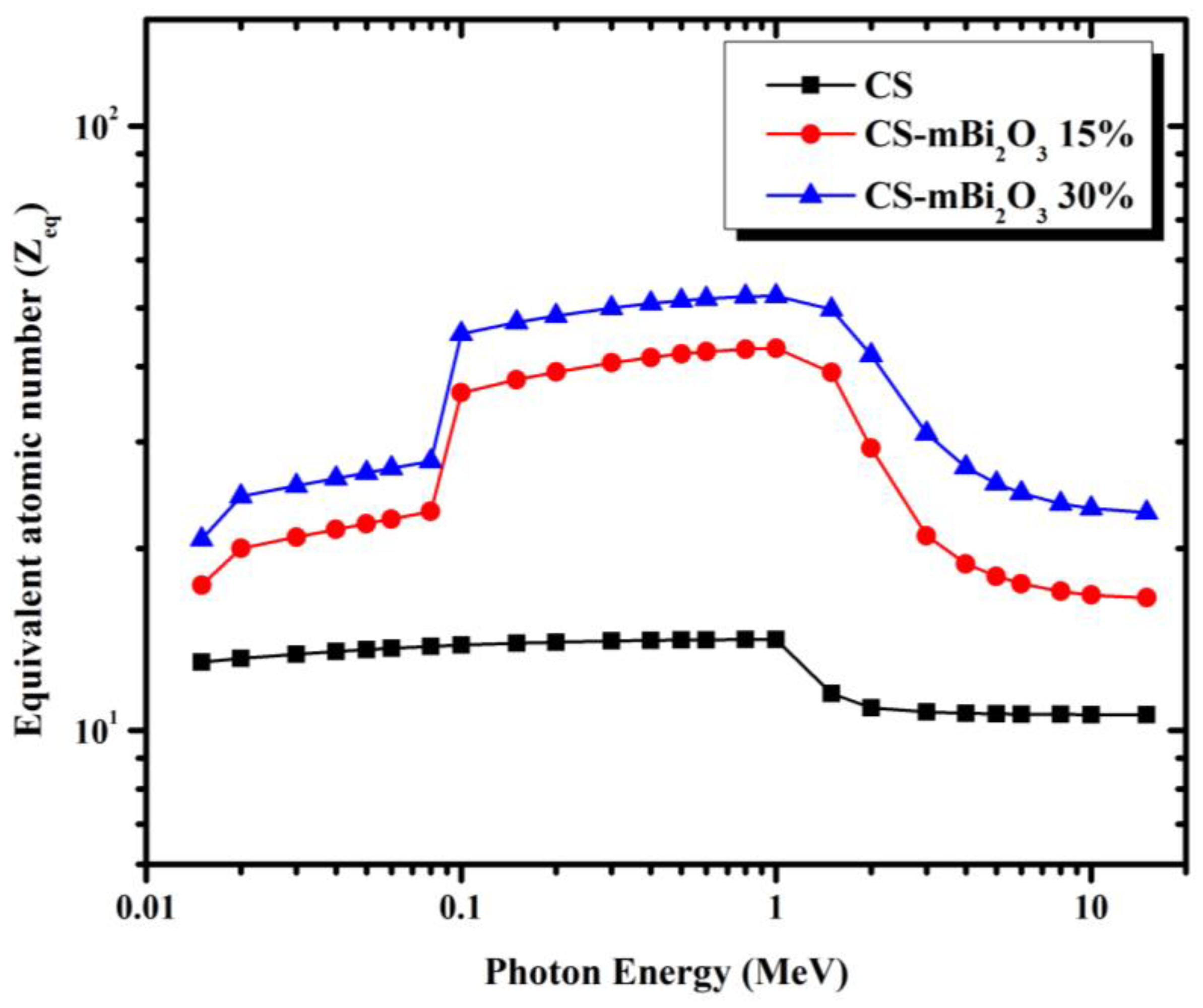
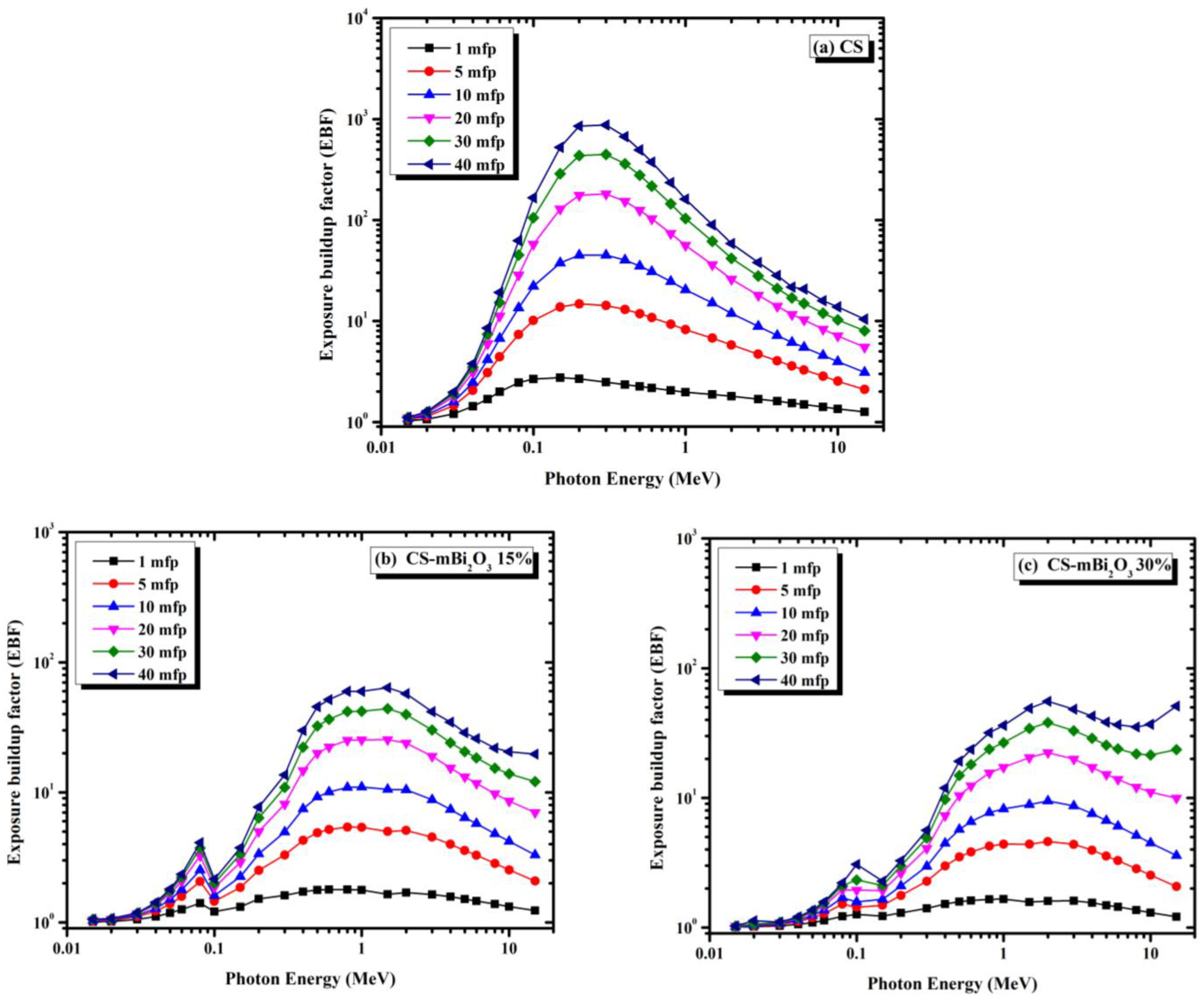
| Element | White Cement (w%) | Sand (w%) |
|---|---|---|
| C | 0.0927 | 0.136 |
| O | 0.5080 | 0.561 |
| Al | 0.0105 | 0.0034 |
| Si | 0.0660 | 0.0042 |
| S | 0.0228 | 0.0008 |
| Ca | 0.3000 | 0.285 |
| Na | - | 0.0015 |
| Mg | - | 0.0027 |
| K | - | 0.0024 |
| Ti | - | 0.0011 |
| Fe | - | 0.0019 |
| Sample | Density g/cm3 | Cement | Fine Sand | Bi2O3 Microparticles | Bi2O3 Nanoparticles |
|---|---|---|---|---|---|
| Pure CS | 1.477 ± 0.002 | 1 | 3 | 0 | 0 |
| CS-mBi2O3 15% | 2.795 ± 0.005 | 1 | 2.7 | 0.3 | - |
| CS-m Bi2O3 30% | 2.972 ± 0.003 | 1 | 2.1 | 0.9 | - |
| CS-n Bi2O3 15% | 2.786 ± 0.004 | 1 | 2.7 | - | 0.3 |
| CS-n Bi2O3 30% | 3.439 ±0.003 | 1 | 2.1 | - | 0.9 |
| PTB | Nuclide Activity (kBq) | Reference Date | Uncertainty (kBq) |
|---|---|---|---|
| 241Am | 259.0 | 00:00 Hr 1. June 2009 | ±2.6 |
| 133Ba | 275.3 | ±2.8 | |
| 152Eu | 290.0 | ±4.0 | |
| 137Cs | 385.0 | ±4.0 | |
| 60Co | 212.1 | ±1.5 |
| Sample | Energy (MeV) | Mass Attenuation Coefficient (cm2 g−1) | ||||
|---|---|---|---|---|---|---|
| Micro | XCOM | ∆ % | Nano | % | ||
| CS | 0.0595 | 0.2825 ± 0.0031 | 0.2838 | −0.47 | ||
| 0.0810 | 0.1994 ± 0.0011 | 0.1999 | −0.26 | |||
| 0.1218 | 0.1540 ± 0.0024 | 0.1537 | 0.18 | |||
| 0.2447 | 0.1154 ± 0.0022 | 0.1166 | −1.05 | |||
| 0.3560 | 0.1001 ± 0.0009 | 0.1011 | −1.03 | |||
| 0.6617 | 0.0779 ± 0.0028 | 0.0781 | −0.24 | |||
| 0.7789 | 0.0725 ± 0.0032 | 0.0725 | 0.03 | |||
| 0.9641 | 0.0661 ± 0.0033 | 0.0655 | 0.85 | |||
| 1.1730 | 0.0588 ± 0.0005 | 0.0595 | −1.08 | |||
| 1.3320 | 0.0555 ± 0.0005 | 0.0558 | −0.53 | |||
| 1.4080 | 0.0538 ± 0.0002 | 0.0542 | −0.72 | |||
| CS-m Bi2O3 15% | 0.0595 | 0.8005 ± 0.0018 | 0.8255 | −3.03 | 0.9498 ± 0.0062 | 18.65% |
| 0.0810 | 0.4160 ± 0.0036 | 0.4308 | −3.45 | 0.4909 ± 0.0041 | 18.01% | |
| 0.1218 | 0.5291 ± 0.0004 | 0.5350 | −1.10 | 0.6195 ± 0.0013 | 17.09% | |
| 0.2447 | 0.1705 ± 0.0021 | 0.1749 | −2.52 | 0.1981 ± 0.0040 | 16.17% | |
| 0.3560 | 0.1191 ± 0.0031 | 0.1219 | −2.33 | 0.1372 ± 0.0041 | 15.27% | |
| 0.6617 | 0.0791 ± 0.0030 | 0.0815 | −2.92 | 0.0903 ± 0.0085 | 14.12% | |
| 0.7789 | 0.0755 ± 0.0012 | 0.0745 | 1.34 | 0.0850 ± 0.0026 | 12.64% | |
| 0.9641 | 0.0671 ± 0.0002 | 0.0663 | 1.18 | 0.0749 ± 0.0062 | 11.66% | |
| 1.1730 | 0.0591 ± 0.0032 | 0.0597 | −1.02 | 0.0657 ± 0.0051 | 11.20% | |
| 1.3320 | 0.0563 ± 0.0051 | 0.0558 | 1.07 | 0.0622 ± 0.0033 | 10.45% | |
| 1.4080 | 0.0543 ± 0.0005 | 0.0542 | 0.33 | 0.0591 ± 0.0016 | 8.78% | |
| CS-m Bi2O3 30% | 0.0595 | 1.3128 ± 0.0024 | 1.3670 | −3.96 | 1.6061 ± 0.0044 | 22.34% |
| 0.0810 | 0.6543 ± 0.0031 | 0.6618 | −1.13 | 0.7846 ± 0.0021 | 19.91% | |
| 0.1218 | 0.9026 ± 0.0008 | 0.9165 | −1.52 | 1.0655 ± 0.0039 | 18.05% | |
| 0.2447 | 0.2293 ± 0.0005 | 0.2332 | −1.65 | 0.2704 ± 0.0026 | 17.92% | |
| 0.3560 | 0.1372 ± 0.0034 | 0.1427 | −3.88 | 0.1596 ± 0.0015 | 16.39% | |
| 0.6617 | 0.0833 ± 0.0029 | 0.0849 | −1.86 | 0.0960 ± 0.0034 | 15.16% | |
| 0.7789 | 0.0765 ± 0.0035 | 0.0764 | 0.11 | 0.0871 ± 0.0082 | 13.88% | |
| 0.9641 | 0.0685 ± 0.0001 | 0.0671 | 2.09 | 0.0768 ± 0.0033 | 12.02% | |
| 1.1730 | 0.0607 ± 0.0022 | 0.0599 | 1.33 | 0.0678 ± 0.0003 | 11.70% | |
| 1.3320 | 0.0572 ± 0.0009 | 0.0558 | 2.51 | 0.0634 ± 0.0063 | 10.91% | |
| 1.4080 | 0.0553 ± 0.0027 | 0.0541 | 2.12 | 0.0605 ± 0.0094 | 9.43% | |
Disclaimer/Publisher’s Note: The statements, opinions and data contained in all publications are solely those of the individual author(s) and contributor(s) and not of MDPI and/or the editor(s). MDPI and/or the editor(s) disclaim responsibility for any injury to people or property resulting from any ideas, methods, instructions or products referred to in the content. |
© 2023 by the authors. Licensee MDPI, Basel, Switzerland. This article is an open access article distributed under the terms and conditions of the Creative Commons Attribution (CC BY) license (https://creativecommons.org/licenses/by/4.0/).
Share and Cite
Gouda, M.M.; El-Khatib, A.M.; Abbas, M.I.; Al-Balawi, S.M.; Alabsy, M.T. Gamma Attenuation Features of White Cement Mortars Reinforced by Micro/Nano Bi2O3 Particles. Materials 2023, 16, 1580. https://doi.org/10.3390/ma16041580
Gouda MM, El-Khatib AM, Abbas MI, Al-Balawi SM, Alabsy MT. Gamma Attenuation Features of White Cement Mortars Reinforced by Micro/Nano Bi2O3 Particles. Materials. 2023; 16(4):1580. https://doi.org/10.3390/ma16041580
Chicago/Turabian StyleGouda, Mona M., Ahmed M. El-Khatib, Mahmoud I. Abbas, Shoaa Mofleh Al-Balawi, and Mahmoud T. Alabsy. 2023. "Gamma Attenuation Features of White Cement Mortars Reinforced by Micro/Nano Bi2O3 Particles" Materials 16, no. 4: 1580. https://doi.org/10.3390/ma16041580
APA StyleGouda, M. M., El-Khatib, A. M., Abbas, M. I., Al-Balawi, S. M., & Alabsy, M. T. (2023). Gamma Attenuation Features of White Cement Mortars Reinforced by Micro/Nano Bi2O3 Particles. Materials, 16(4), 1580. https://doi.org/10.3390/ma16041580






